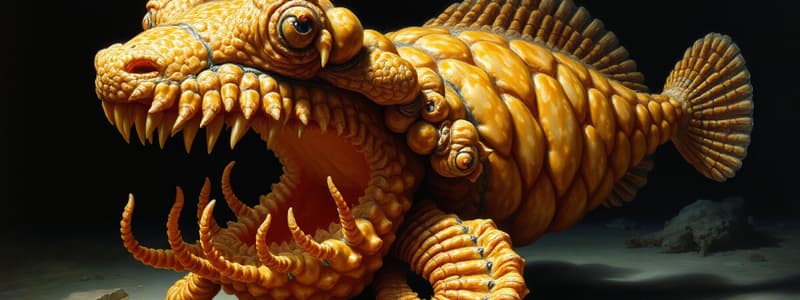Podcast
Questions and Answers
What are characteristics of the Class Ascidiacea?
What are characteristics of the Class Ascidiacea?
- Predatory behavior
- Free-swimming adults
- Sessile benthic species (correct)
- Invasive species (correct)
The dorsal hollow nerve cord and notochord are present in adult Ascidiacea.
The dorsal hollow nerve cord and notochord are present in adult Ascidiacea.
False (B)
What do suspension feeders do?
What do suspension feeders do?
They trap suspended food particles by generating a water current.
What is the primary function of the stomach in Ascidiacea?
What is the primary function of the stomach in Ascidiacea?
What is the role of the intestine in Ascidiacea?
What is the role of the intestine in Ascidiacea?
What type of bacteria is prochloron?
What type of bacteria is prochloron?
What does the endostyle produce?
What does the endostyle produce?
Where does water move into in Ascidiacea?
Where does water move into in Ascidiacea?
Which types of feeders are found in Ascidiacea?
Which types of feeders are found in Ascidiacea?
What does the body wall of Ascidiacea consist of?
What does the body wall of Ascidiacea consist of?
What is the function of vandocytes?
What is the function of vandocytes?
How does concrete vanadium enter the tunic?
How does concrete vanadium enter the tunic?
What is the primary function of the blood vascular system in Ascidiacea?
What is the primary function of the blood vascular system in Ascidiacea?
How does excretion occur in Ascidiacea?
How does excretion occur in Ascidiacea?
What type of reproductive strategies do Ascidiacea exhibit?
What type of reproductive strategies do Ascidiacea exhibit?
What changes occur during the metamorphosis of the tadpole larva?
What changes occur during the metamorphosis of the tadpole larva?
Flashcards are hidden until you start studying
Study Notes
Ascidiacea (Sea Squirts)
- Ascidiacea are sessile benthic species and include invasive species, affecting marine ecosystems.
Anatomical Features
- Dorsal hollow nerve cord and notochord are absent in adult ascidians, distinguishing them from many other chordates.
Feeding Mechanism
- They are suspension feeders, generating a water current using lateral cilia.
- An endostyle secretes iodine-containing mucoprotein, forming two net sheets to trap plankton.
- Frontal cilia spread the net across gill slits as water flows through.
- Trapped food is directed through the dorsal lamina, which rolls the net into a cord and shunts it to the esophagus.
Digestive System
- The stomach is primarily responsible for digestion.
- The intestine focuses on absorption and fecal pellet formation.
Symbiotic Relationships
- Prochloron, a type of cyanobacteria, can commonly coexist with ascidians.
Glandular Structures
- The endostyle serves as a glandular structure producing mucus nets essential for feeding.
Water Movement
- Water flows into the ascidian through the buccal siphon, facilitating the filtration process.
Feeding Types
- Ascidians can be carnivorous, with some species acting as deposit feeders, though they are less common.
Body Structure
- The body wall features a tunic composed of approximately 60% cellulose, along with protein and other carbohydrates, providing support and protection.
- The adult tunic is multilayered and grows with the organism without molting.
Defense Mechanisms
- Vandocytes in the tunic act as an antifouling agent, preventing unwanted growth and serving in anti-predatory roles by affecting movement and enzyme function.
Chemical Composition
- Concrete vanadium enters the tunic from the blood and includes elements like H2SO4, which may have toxic properties and play a role in tunic synthesis.
Circulatory System
- The blood vascular system includes a tubular heart and gill vessels for gas exchange, supported by cilia that facilitate respiratory water flow.
- Various cell types within the system, such as lymphocytes and vacuolated cells, contribute to homeostasis and immune functions.
Excretion Process
- Ammonia diffuses across the pharynx to the atrial siphon for excretion, without nephridia present in adults.
- Ammonia can be converted to uric acid for storage, serving as a nitrogenous waste product.
Nervous System
- Composed of a cerebral ganglion derived from the neural tube, extending nerves anteriorly and posteriorly.
- No specialized sensory organs exist in adults, whereas larvae possess statocysts and ocelli for navigation.
Reproductive Strategies
- Reproduction occurs via asexual budding and sexual methods, with most species being hermaphroditic.
- Embryonic development involves bilateral cleavage and indirect development with a larval stage.
Tadpole Larva
- The larva features a trunk and a tail used for locomotion, with both a dorsal hollow nerve cord and notochord.
- The tail provides structural support and allows for bending without risking muscle shortening.
Metamorphosis
- As the tadpole settles, its tail retracts, and degenerative processes occur in the nerve cord, notochord, and tail muscles during metamorphosis.
Studying That Suits You
Use AI to generate personalized quizzes and flashcards to suit your learning preferences.
